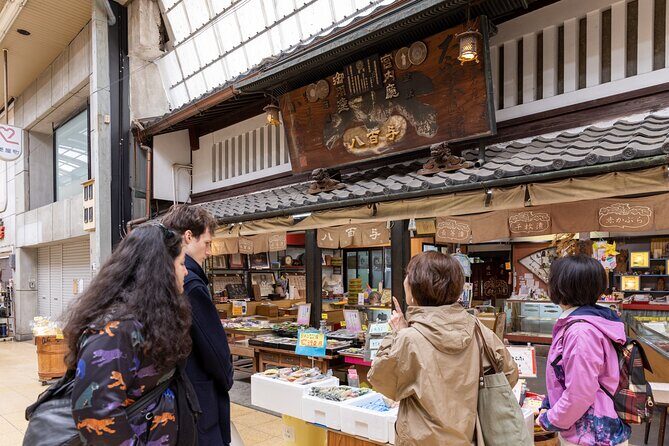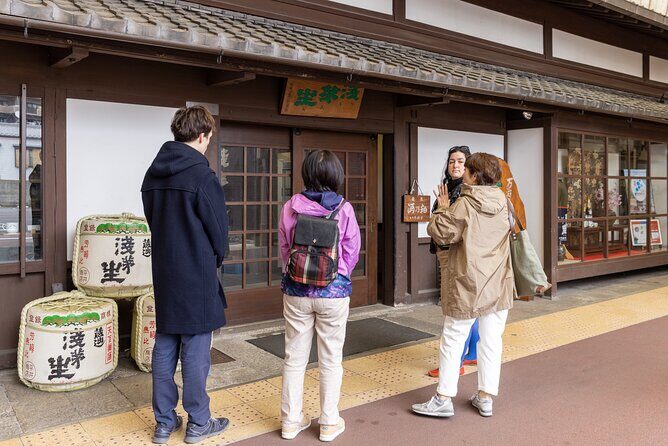A Genuine Look at Otsu-e Folk Art and Local Culture Near Kyoto
If you’re visiting Kyoto and craving a more personal, off-the-beaten-path cultural experience, this 3.5-hour Otsu-e Folk Art Workshop & Local Culture Walk offers a fascinating peek into Japan’s traditional folk art scene. Led by Misato Takahashi, a passionate native and direct descendant of Otsu-e master artists, you’ll explore the lakeside town of Otsu—a mere 10-minute train ride from Kyoto—and discover its unique artistic heritage. The tour combines visits to historic sites, local shops, and an engaging hands-on art workshop, making it a well-rounded and authentic cultural escape.
What we love most about this experience is Misato’s deep knowledge and her personal connection to the art form, which brings an extra layer of authenticity. Plus, the chance to create your own Otsu-e Oni bell or Lucky Oni is a memorable highlight. It’s a chance to both learn about and participate in a craft that’s been part of Otsu’s culture for over 400 years.
A potential consideration might be the physical pace—the tour involves walking through town, visiting several historical sites and shops, and participating in a hands-on workshop, so moderate physical fitness is recommended. Also, the tour’s 3.5-hour duration might feel tight if you prefer more relaxed, unhurried visits or want to incorporate a longer lunch.
This tour is best suited for travelers interested in traditional Japanese crafts, local history, and interactive experiences. It’s especially appealing if you enjoy stories behind art forms and want a meaningful souvenir to take home.
Key Points
- Authentic Cultural Focus: Led by a native guide, the tour emphasizes genuine local artistry and history.
- Interactive Creativity: Creating your own Otsu-e Oni bell makes for a memorable, hands-on souvenir.
- Accessible and Convenient: Only a 10-minute train ride from Kyoto, perfect for a half-day trip.
- Comprehensive Itinerary: From historic sites and local shops to a detailed art workshop, you get a well-rounded experience.
- In-Depth Knowledge: The guide’s storytelling adds rich context, making the visit both educational and engaging.
- Value for the Price: Around $113, including many entry fees and a personalized activity, it offers substantial cultural value.
Exploring Otsu-e Folk Art and the Town’s Charm

Imagine stepping into a town where art is woven into everyday life, and every shop and corner echoes centuries of tradition. That’s what you get with this tour. Starting at Otsu Station, we’re immediately greeted by a peaceful lakeside atmosphere, a stark contrast to Kyoto’s bustling streets. The short walk to Kekaiji Temple reveals ginkgo trees that historically guided boats on Lake Biwa, providing a picturesque first stop that hints at the area’s maritime importance.
If you're drawn to exploring Otsu on foot, we've looked into these other walking experiences
The Town’s Historic and Cultural Gems
From there, your guide takes you to Mochihyo, a traditional Japanese sweets shop facing the old Tokaido Road. Picking up confections to enjoy later, you’ll see how local flavors and sweets are intertwined with Otsu’s cultural fabric. Just a few steps further, Senmaruya dried food store offers a glimpse into Japan’s preserved culinary traditions, with retro snacks that taste like a trip back in time.
The Hirai Shoten sake brewery, with 365 years of history, serves as a reminder of Otsu’s long-standing relationship with sake brewing. Sipping a local brew here, you can appreciate how craft and community are still alive in this small town. Near the Otsu Festival Hikiyama Exhibition Pavilion, a float from the famous Otsu Festival is on display, offering a peek into the lively local celebrations.
Discovering the Historic Merchants’ Houses and Local Specialties
Next, the well-preserved Otsu Hyakuchokan merchant house provides a window into traditional town life, with a guided tour that offers insight into Otsu’s commercial past. The visit to Yaoyo Pickle Shop introduces you to Japanese dietary staples—pickles that have been made here for generations—giving you a taste (literally and figuratively) of local culinary culture.
The Heart of the Artistic Experience
The highlight for many is the visit to Otsu-e no Mise in Miidera Sando, where you’ll see the traditional folk paintings and learn their stories. Succeeded by the 5th-generation Takahashi Shozan, this shop is a living museum of Otsu-e art. The real magic happens at Ichie Wado Seminar House, where the hands-on Otsu-e Oni Bell painting workshop takes place. Here, you’ll watch a presentation on the history of this folk art, enjoy welcome tea and sweets, and then get creative yourself.
The Art Workshop: Making Your Own Otsu-e Oni Bell
The workshop, which lasts about 1.5 hours, transforms you from an observer into an artist. Guided by Misato, you’ll learn the technique of painting traditional folk motifs—like the iconic Oni (demon) face—on a small bell or figurine. Reviews highlight how much fun and meaningful this part of the tour can be, with visitors sharing that they loved the process of creating their own keepsake.
Many reviewers describe the workshop as more than just a craft session; it’s an educational experience. One noted, “I appreciated the cultural origins and stories of the folk art she shares, authentically keeping her family and cultural heritage going.” Others mention how the personal attention from Misato and her storytelling made the experience memorable.
While in Otsu, here are other experiences we've covered
The Value and Practical Aspects
For just under $113 per person, this tour includes all the admission fees to the key sites and the workshop itself, plus local snacks and souvenirs. This makes it a good deal considering the variety of experiences packed into a single half-day. The tour’s logistics, with a 10-minute train ride from Kyoto and walking through charming streets, make it accessible and convenient.
While the cost might seem steep compared to free museum visits, the personal guidance, hands-on activity, and local stories add significant value. You walk away with a tangible souvenir that embodies Otsu’s artistic spirit.
Authenticity and Depth
What keeps this experience stand out is the genuine connection to local culture. Travelers consistently praise Misato’s passion and her ability to tell stories that illuminate the art and history. As one reviewer put it, “She took us through the process like a wonderful teacher and was a great chat over tea and snacks.” This kind of personal touch is what makes the tour more than just sightseeing—it’s an educational journey.
Who Will Love This Tour?

This experience is perfect for travelers who appreciate traditional crafts, storytelling, and hands-on participation. If you enjoy arts and crafts, the chance to create your own folk art piece will resonate. It also suits those interested in local Japanese culture, especially if they have an appreciation for history, community traditions, and regional specialties.
However, if you prefer a leisurely pace or are traveling with very young children or those with limited mobility, you might want to consider the physical demands of walking and standing during some stops.
Final Thoughts

In a landscape filled with temples and shrines, this tour offers something refreshingly different—an authentic look into Japan’s living folk art tradition. You’re not just a passive visitor; you become part of the story, creating a piece of art and learning about a craft that’s been kept alive by dedicated artisans for centuries.
The combination of historical sites, tasty local treats, and the unique workshop makes this trip rewarding and memorable. It’s a fantastic option if you want to experience Japan beyond its famous sights, diving into its lesser-known crafts and stories.
In short, this tour is an excellent fit for curious travelers who crave meaningful cultural interactions, enjoy hands-on activities, and value storytelling that brings history to life. Expect a day filled with creativity, discovery, and genuine local charm.
FAQ
How long is the tour?
It lasts approximately 3 hours and 30 minutes, including visits to multiple sites and the art workshop.
Where does the tour start and end?
It begins at the North ticket gate of Otsu Station and concludes at the Ichie Wado Seminar House, where the painting workshop takes place.
What is included in the price?
The fee covers the guided walk, all entrance fees to key sites like Otsu Hyakuchokan and the float exhibition hall, the art workshop, local snacks, sweets, and souvenirs.
Do I need to pay extra for train fare?
Train fare from Kyoto to Otsu (around JPY200) is not included but can be covered if you have a JR Pass.
Is this tour suitable for children or those with limited mobility?
Moderate physical fitness is recommended. The tour involves walking and some standing, but it’s generally manageable for most with average mobility.
Can I cancel if my plans change?
Yes, cancellations are free if made at least 24 hours in advance. Late cancellations are non-refundable.
Is the tour private or group?
It is a private tour, so only your group will participate, allowing for a personalized experience.
What’s the highlight of the tour?
Most say the hands-on Otsu-e Oni bell painting and learning about the art form’s history with Misato are the best parts.
Can I buy souvenirs or art pieces?
Yes, the shop at Miidera Sando offers original Otsu-e folk art paintings and souvenirs, perfect for keepsakes or gifts.
In summary, this tour offers a well-balanced blend of history, art, and local flavor. It’s ideal for those wanting a meaningful, interactive glimpse into Japan’s traditional crafts, fueled by passionate guides and beautiful surroundings. Whether you’re an art lover, history buff, or curious traveler, this experience will leave you with a new appreciation for Otsu’s artistic heritage—and perhaps a new handmade bell to remind you of Japan’s enduring creative spirit.
More Workshops & Classes in Otsu
More Walking Tours in Otsu
More Tour Reviews in Otsu
- Otsu: Ishiyama-dera Sacred Stone Temple by Lake Biwa
- Shiga: Discover Otsu-e, Japans Hidden Edo Pop Art Tradition
- Shiga: Discover Otsus History, Culture, and Faith on Foot
- Shiga Cycling Tour Southern Lake Biwa Loop
- Shiga: Sakamoto Walking Tour of Stone Walls Faith and History
- Shiga : Otsu Bar Hopping with Local Food in Your Chosen Area
More Otsu experiences we've covered
- Otsu: Ishiyama-dera Sacred Stone Temple by Lake Biwa
- Shiga: Discover Otsu-e, Japans Hidden Edo Pop Art Tradition
- Shiga: Discover Otsus History, Culture, and Faith on Foot
- Shiga Cycling Tour Southern Lake Biwa Loop
- Shiga: Sakamoto Walking Tour of Stone Walls Faith and History
- Shiga : Otsu Bar Hopping with Local Food in Your Chosen Area
- Kyoto: Discover Mount Hieis Three Sacred Precincts
- Home Visit and Mochi Pounding Experience near Kyoto
- Kyoto: Enryakuji Highlights 2-Hour Sacred Express Tour
- Lake Biwa Casual E Bike Rental
- Private 3 Hours Waterfalls Sightseeing Tour
- Otsu: Miidera Temple with the Spirit of Mount Hiei
